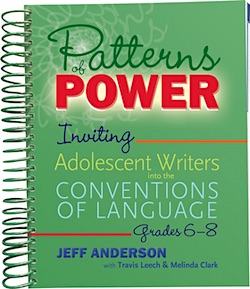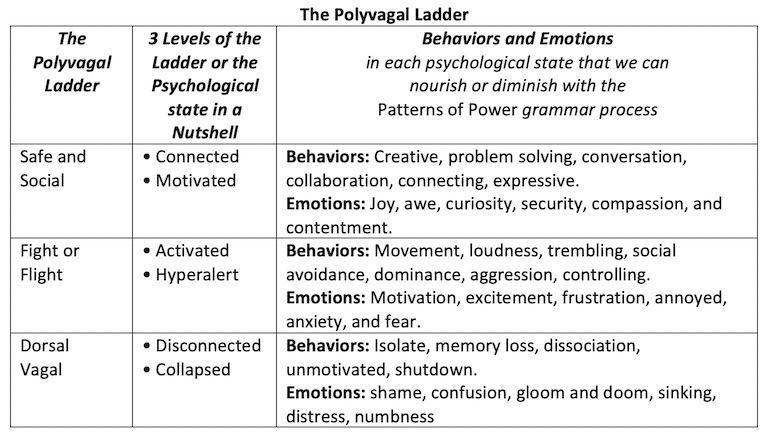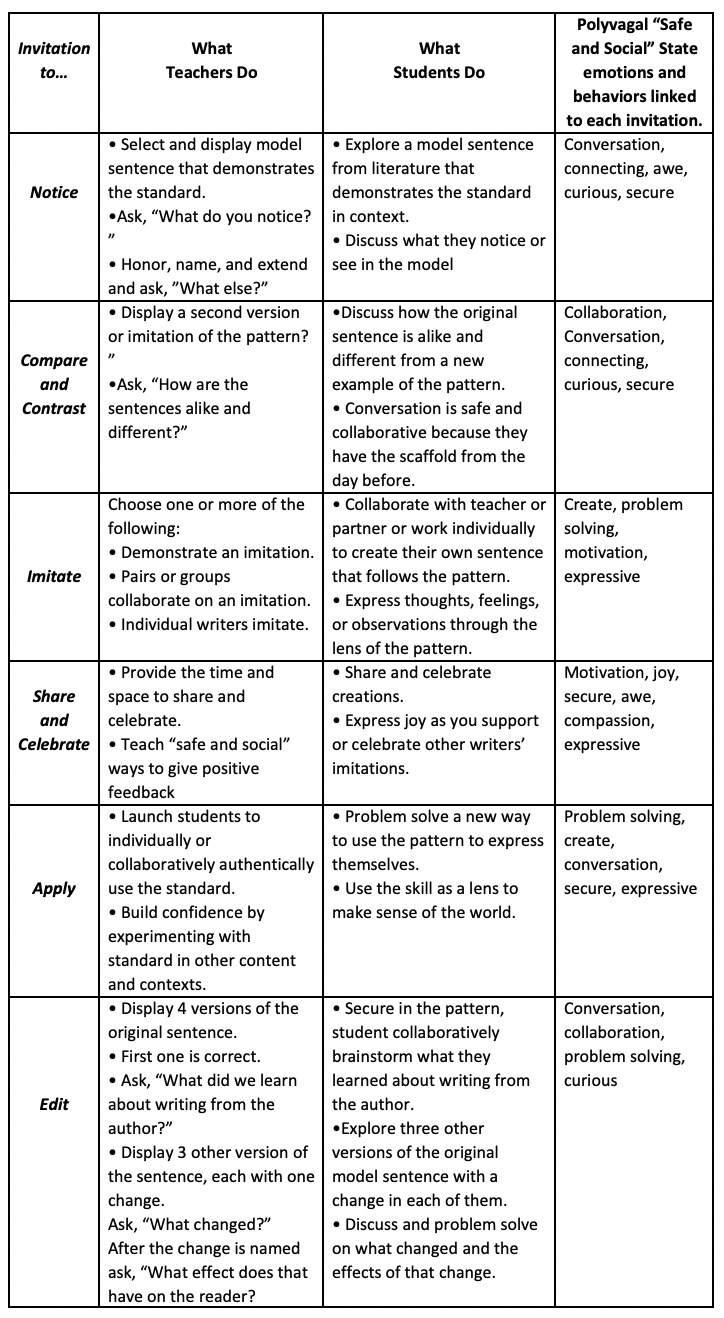Grammar Instruction the Safe and Social Way
A middle school approach to grammar instruction that’s all about connections, not corrections.
By Jeff Anderson and Travis Leech

Enter middle grade grammar instruction: How are we supposed to make language or convention learning safe and social?

Patterns of Power
The Patterns of Power process is an alternative that supports students meeting and exceeding language, grammar, or convention standards through positive play and cultivation of curiosity.
In addition, if we add and name a layer of “safe and social principles” (Dana, 2018) throughout this invitational process, we will connect reading and writing with the bridge of conventions that activate meaning – the “safe and social” hallmarks of conversation, collaboration, curiosity, and creation.
The order of the process, with the invitational method of instruction, helps create a “safe and social” environment that will set your middle grade students free to explore possibilities, meaning, and purpose.
The Polyvagal Ladder
The “safe and social” concept comes from the work of Porges and Dana – called the Polyvagal Ladder – which describes three psychological states in which we can dwell.
These three states are described in Deb Dana’s The Polyvagal Theory in Therapy (2018). In short, the Polyvagal Ladder identifies three states of our nervous system, starting at the bottom in a shutdown or frozen state and rising to the top of the ladder to the safe and social state.
In our lives, we are constantly observing cues in our environment, which either move us up or down the polyvagal ladder. Safety signals move us up the ladder, while danger signals move us down.
When you look at the chart below, consider how our students are constantly stuck or moving through these states. Wouldn’t it be great, if with a few shifts, our grammar instruction could move our middle grade students up the ladder, closer to a feeling of safety and security? Often, traditional correction-oriented grammar instruction moves students down the ladder into collapse or giving up.
Once you’ve looked at the Polyvagal Ladder chart, we bet there isn’t any one of us who can’t think of a situation where someone’s “correction” shut us down or moved us to the bottom of the ladder (dorsal vagal state).
In the same way, it is our hope that you’ll recall some form of belonging or connectedness that made you feel safe, warm, and comfortable. (Of course, there’s a lot more to the polyvagal states. If you’re interested, we recommend you check Deb Dana’s books or online courses.)
For now, let’s step toward understanding how a traditional approach to grammar (correcting errors, memorizing parts of speech) at best sends adolescents into “fight or flight,” and at worse sends them into a shutdown (i.e. they stop writing or trying). In these cases, students often take on an identity of someone who CAN’T do that grammar stuff.
How do we flip grammar from threat and confusion to collaboration and creativity?

What if we move conversations of grammar from a right-or-wrong stance to one of meaning and effect? The conventions of language are indeed crafted by the author’s purpose to telegraph meaning and have an effect on the way our writing is read. Understanding the why and how of author’s purpose and craft is our new goal – meaning and effect.
In the first of the six steps of Patterns of Power, teachers display a beautiful sentence that models the standard or skill we need to teach. For example, if sixth graders were supposed to use and understand relative clauses or pronouns, we certainly wouldn’t begin with something that would give students a sinking feeling in the face of such abstract terminology or definitions.
Nope.
In the Patterns of Power process, we start with a sentence from a high-interest, popular, and inclusive author like Jason Reynolds that has a relative clause or pronoun used in the context of author’s purpose and craft (meaning and effect):
Mr. Charles can barely hear a thing, which is why he’s always yelling at everybody and everybody’s always yelling at him —Jason Reynolds, Ghost
Display the sentence digitally or whatever ways you have in your classroom to share. Follow the steps in the Patterns of Power process in this chart.
Patterns of Power Process
This student-centered Patterns of Power process is facilitated by a teacher and driven by student conversation. We ask questions, clarify, and highlight relevant responses, stretching it out as much as it needs to be. In this way, our direct instruction is response-driven rather than teacher-driven. This process can be done with any skill or book or text.
To browse a generous portion of our book and see how it all works, click this link. You’ll land at our Routledge book page. Click on the preview underneath the cover at the left.
Feature image: @karmenlogan

A companion resource book, Patterns of Power, Grades 1-5 by Jeff Anderson with Whitney LaRocca and the Patterns of Power PLUS grade level kits for Grade 4 & Grade 5, also by Anderson and LaRocca, are recommended for teachers in the intermediate grades.
Jeff Anderson has inspired writers and teachers of grades K-8 with the power and joy of the writing process for more than 30 years. He has written eight books and five kits for Routledge/Stenhouse, including his latest, co-authored with Whitney La Rocca, Patterns of Wonder: Inviting Emergent Writers to Play with the Conventions of Language (Summer 2021). He also writes middle-grade novels, including Sterling’s Zack Delacruz series: Me and My Big Mouth, Just My Luck, and Upstaged. As a classroom teacher turned staff developer and demonstration teacher, Jeff says, “I love the ability to spark curiosity and creativity and to support people in finding their voices. That’s pure joy.”
Travis Leech grew up loving to read and filling spiral notebooks with stories of fantasy and adventure. He never enjoyed grammar instruction in school, and was never top of his class at diagramming sentences or finding the 10 mistakes in paragraphs riddled with errors. As he was beginning his ELA teaching career, Travis discovered Jeff Anderson’s books Mechanically Inclined and Everyday Editing. He has since incorporated Jeff’s grammar invitations into his work as a middle school teacher, gifted and talented specialist, and now instructional coach in San Antonio, TX.




































